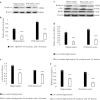High-protein and low-calorie diets improved the anti-aging Klotho protein in the rats' brain: the toxic role of high-fat diet
- PMID: 33072166
- PMCID: PMC7559193
- DOI: 10.1186/s12986-020-00508-1
High-protein and low-calorie diets improved the anti-aging Klotho protein in the rats' brain: the toxic role of high-fat diet
Abstract
Background: In the current study, our specific aim was to characterize the Klotho protein and expression levels in the hippocampus and prefrontal cortex of old rats treated with different diets (high-fat, high-protein, low-calorie, high-protein and low-calorie).
Methods: Rats were treated with high-fat, high-protein, low-calorie, low-calorie high-protein diets for 10 weeks and then behavioral and molecular assessments were evaluated.
Results: Statistical analysis showed the percentage of open arm time was increased in the high-protein, low-calorie and low-calorie high-protein groups compared with old control (old-C) rats. The percentage of open arm entries was increased in the low-calorie and low-calorie high-protein group compared with old-C rats. The body weight and serum triglyceride were decreased in the low-calorie and low-calorie high-protein groups in comparison to control old rats. Low-calorie and low-calorie high-protein treatments statistically enhanced caspase-3 level compared with old-C rats in the hippocampus and prefrontal cortex. Treatment of old rats with high-protein, low-calorie and low-calorie high-protein could increase Klotho-α level compared with control old rats. The levels of Klotho-α, c-fos and brain-derived neurotrophic factors were decreased in the low-calorie high-protein group in Klotho inhibitor's presence compared with the low-calorie high-protein group.
Conclusion: According to our findings, Klotho-α level was reduced in old rats. Low-calorie, high-protein and particularly low-calorie high-protein diets increased this protein level and consequently increased neuronal plasticity and improved memory function.
Keywords: FGF23; High-protein diet; Klotho; Low-calorie diet; c-fos.
© The Author(s) 2020.
Conflict of interest statement
Competing interestsThe authors declare they have no conflict of interests.
Figures




Similar articles
-
Long-term consumption of fermented pork fat-based diets differing in calorie, fat content, and fatty acid levels mediates oxidative stress, inflammation, redox imbalance, germ cell apoptosis, disruption of steroidogenesis, and testicular dysfunction in Wistar rats.Environ Sci Pollut Res Int. 2023 Apr;30(18):52446-52471. doi: 10.1007/s11356-023-26018-0. Epub 2023 Feb 25. Environ Sci Pollut Res Int. 2023. PMID: 36840878
-
Effect of different levels of calorie restriction on azoxymethane-induced colon carcinogenesis in male F344 rats.Cancer Res. 1990 Sep 15;50(18):5761-6. Cancer Res. 1990. PMID: 2393850
-
Phosphorus restriction does not prevent the increase in fibroblast growth factor 23 elicited by high fat diet.PLoS One. 2018 Jun 1;13(6):e0198481. doi: 10.1371/journal.pone.0198481. eCollection 2018. PLoS One. 2018. PMID: 29856857 Free PMC article.
-
Beneficial effect of low carbohydrate in low calorie diets on visceral fat reduction in type 2 diabetic patients with obesity.Diabetes Res Clin Pract. 2004 Sep;65(3):235-41. doi: 10.1016/j.diabres.2004.01.008. Diabetes Res Clin Pract. 2004. PMID: 15331203 Clinical Trial.
-
Diet and body composition. Effect of very low calorie diets and exercise.Sports Med. 1991 Oct;12(4):237-49. doi: 10.2165/00007256-199112040-00003. Sports Med. 1991. PMID: 1784876 Review.
Cited by
-
Soluble Klotho, a Potential Biomarker of Chronic Kidney Disease-Mineral Bone Disorders Involved in Healthy Ageing: Lights and Shadows.Int J Mol Sci. 2024 Feb 3;25(3):1843. doi: 10.3390/ijms25031843. Int J Mol Sci. 2024. PMID: 38339121 Free PMC article. Review.
-
Improving Brain Creatine Uptake by Klotho Protein Stimulation: Can Diet Hit the Big Time?Front Nutr. 2021 Dec 23;8:795599. doi: 10.3389/fnut.2021.795599. eCollection 2021. Front Nutr. 2021. PMID: 35004821 Free PMC article. No abstract available.
-
Dietary Macronutrients Do Not Differently Influence Postprandial Serum and Plasma Brain-Derived Neurotrophic Factor Concentrations: A Randomized, Double-Blind, Controlled Cross-Over Trial.Front Neurosci. 2021 Dec 21;15:774915. doi: 10.3389/fnins.2021.774915. eCollection 2021. Front Neurosci. 2021. PMID: 34992516 Free PMC article.
-
Individual nutrients and serum klotho levels in adults aged 40-79 years.Food Sci Nutr. 2023 Mar 8;11(6):3279-3286. doi: 10.1002/fsn3.3310. eCollection 2023 Jun. Food Sci Nutr. 2023. PMID: 37324910 Free PMC article.
-
Surfeit folic acid, protein, and exercise modify oncogenic inflammatory biomarkers and fecal microbiota.Front Nutr. 2023 Jan 19;9:1060212. doi: 10.3389/fnut.2022.1060212. eCollection 2022. Front Nutr. 2023. PMID: 36742002 Free PMC article.
References
LinkOut - more resources
Full Text Sources
Research Materials

